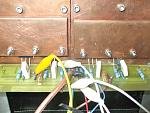I've noticed on the Pass products the use of oversized washers on output devices to help spread out the force of the mounting bolts. Are these standard washers or special order? I like the idea, and would like to use it on some of my amps where the output devices are blowing a lot of power.
Lol, that is a criminal offence in some countries....where is DIY spirit ?

Went to Lowe's after work - gottem washer. I'll see if they make a difference in device temperature, especially with high dissipation designs like "Le Mutant" and the "SiC Puppy.
Such a shame yeahin some countries wasting weed and booze is also criminal
so - who cares ?
especially if Government is so efficient and responsible ....... as "mine"
Firefighter gets high - YouTube
Watch that and laugh a bit.
The best method of clamping a plastic case transistor is with a belleville washer.
Belleville washer - Wikipedia, the free encyclopedia
In my high dissipation designs I use a small heatsink similar to what you would PC mount on a TO-220 case on the plastic side of the case and directly connect the metal faced side to a .125" thick copper plate. The copper heat spreader ( about 4 square inches or more per device) is then insulated from the heat sink with either the thermal rubber sheet material or paper coated with metal oxide filled silicone grease. The whole assembly is clamped with a steel screw and belleville washer.
This gives me the best heat transfer of any method I have tried.
Belleville washer - Wikipedia, the free encyclopedia
In my high dissipation designs I use a small heatsink similar to what you would PC mount on a TO-220 case on the plastic side of the case and directly connect the metal faced side to a .125" thick copper plate. The copper heat spreader ( about 4 square inches or more per device) is then insulated from the heat sink with either the thermal rubber sheet material or paper coated with metal oxide filled silicone grease. The whole assembly is clamped with a steel screw and belleville washer.
This gives me the best heat transfer of any method I have tried.
The even beterer method.....😀
I use trough bolts (sorry for metric mesures) 2 for each of the Mosfets
instead of the single M3 screw.
Such bolts can be any size you like (doing quite well with M4 or M5) the head is burried on the heath spreader so it will not spin around and a thick clamp bar is bolted down on the top of the mosfet with nut and washers.
Even with M4 is quite difficoult to strip thetreads.
I recon that pressure is quite a bit more than the single M3 screw with Illegal washers.
Quite handy if you use the Kerafoll stuff as thermalresistance is efected by the clamping pressure.
Unt as VGS is themperature dependent a litle bit morepressure on one of the mosfet may help to match pairs.😀
I use trough bolts (sorry for metric mesures) 2 for each of the Mosfets
instead of the single M3 screw.
Such bolts can be any size you like (doing quite well with M4 or M5) the head is burried on the heath spreader so it will not spin around and a thick clamp bar is bolted down on the top of the mosfet with nut and washers.
Even with M4 is quite difficoult to strip thetreads.
I recon that pressure is quite a bit more than the single M3 screw with Illegal washers.
Quite handy if you use the Kerafoll stuff as thermalresistance is efected by the clamping pressure.
Unt as VGS is themperature dependent a litle bit morepressure on one of the mosfet may help to match pairs.😀
Attachments
The even beterer method.....😀
I use trough bolts (sorry for metric mesures) 2 for each of the Mosfets
instead of the single M3 screw.
Such bolts can be any size you like (doing quite well with M4 or M5) the head is burried on the heath spreader so it will not spin around and a thick clamp bar is bolted down on the top of the mosfet with nut and washers.
Even with M4 is quite difficoult to strip thetreads.
I recon that pressure is quite a bit more than the single M3 screw with Illegal washers.
Quite handy if you use the Kerafoll stuff as thermalresistance is efected by the clamping pressure.
Unt as VGS is themperature dependent a litle bit morepressure on one of the mosfet may help to match pairs.😀
As long as the pressure under the elevated temperature does not cause the case to crack. That is why belleville spring washers are used. You can set the maximum pressure and it stays there!
😀Take quite a bit of Luck to set the maximum presure (pressure at wich the case crack)
with a M3 screw.
Belleville washers or not that tread will strip and then all you have to do is drill new holes or fit a elicoil insert and such.
I am not arguing about Belleville washers or such (Where arguing is intended old way sort of thing for presenting one point of view and discussing its merits and the such for Belleville washers are also known as Coned Spring Washers ) which are quite good by the way epecialy for series parralel flexibility of use.
IMO Only thing that maters is that if you are not cautious the M3 tread will strip much earlier than you normaly will want it to epecialy after swapping a few of the Fuses😀
And much earlier than craking the case elevated themperature of what 50 / 60 C ?
with a M3 screw.
Belleville washers or not that tread will strip and then all you have to do is drill new holes or fit a elicoil insert and such.
I am not arguing about Belleville washers or such (Where arguing is intended old way sort of thing for presenting one point of view and discussing its merits and the such for Belleville washers are also known as Coned Spring Washers ) which are quite good by the way epecialy for series parralel flexibility of use.
IMO Only thing that maters is that if you are not cautious the M3 tread will strip much earlier than you normaly will want it to epecialy after swapping a few of the Fuses😀
And much earlier than craking the case elevated themperature of what 50 / 60 C ?
Last edited:
The best method of clamping a plastic case transistor is with a belleville washer.
The prettiest => http://www.diyaudio.com/forums/atta...8768078-increasing-bias-amps-stark-output.jpg
They're similar to bellevilles, with a pointy edge at each bottom corner, and a non-corrosive goldy locks finish.
(high anxiety me bought so many of them ~2 decades ago that i can't afford other ones for the duration)
But around here we use a #6 or .136 base diameter or 870 lbs breaking strength! (Stainless, 290 regular steel.)
Lol, that is a criminal offence in some countries....
It might be legal if:
You do it with coins of non-local currency at your home country.
Or, sent your coins oversea and ask others to do it for you.
Warning! This is not a legal advise.
- Status
- Not open for further replies.
- Home
- Amplifiers
- Pass Labs
- Big A** Nelson Washers



